Strategic Human Resource Management Report: Barclays Bank
VerifiedAdded on 2022/10/17
|23
|7491
|489
Report
AI Summary
This report provides an executive summary and analysis of the strategic human resource management (SHRM) challenges faced by Barclays Bank, a major UK-based financial institution. It identifies key issues such as diversity, regulations, technology, risk management, client needs, political risks, and human resource risks. The report explores global SHRM best practices, including encouraging creativity, coaching, optimized focus, open communication, leadership development, strategic recruitment, rewarding systems, skill development programs, and performance management. It recommends the "Standard Causal Model" as a strategic planning tool. The report also outlines training strategies, including need analysis, skill gap identification, and evaluation methodologies. Finally, it presents a comprehensive HR implementation plan covering HR needs, employee selection, training development, compensation determination, recruitment strategies, and performance appraisal. The report emphasizes the importance of SHRM in organizational success, especially in the banking sector. The analysis provides valuable insights into the challenges and opportunities for SHRM in a multinational banking environment and offers actionable recommendations for Barclays Bank to improve its HR practices and overall performance.
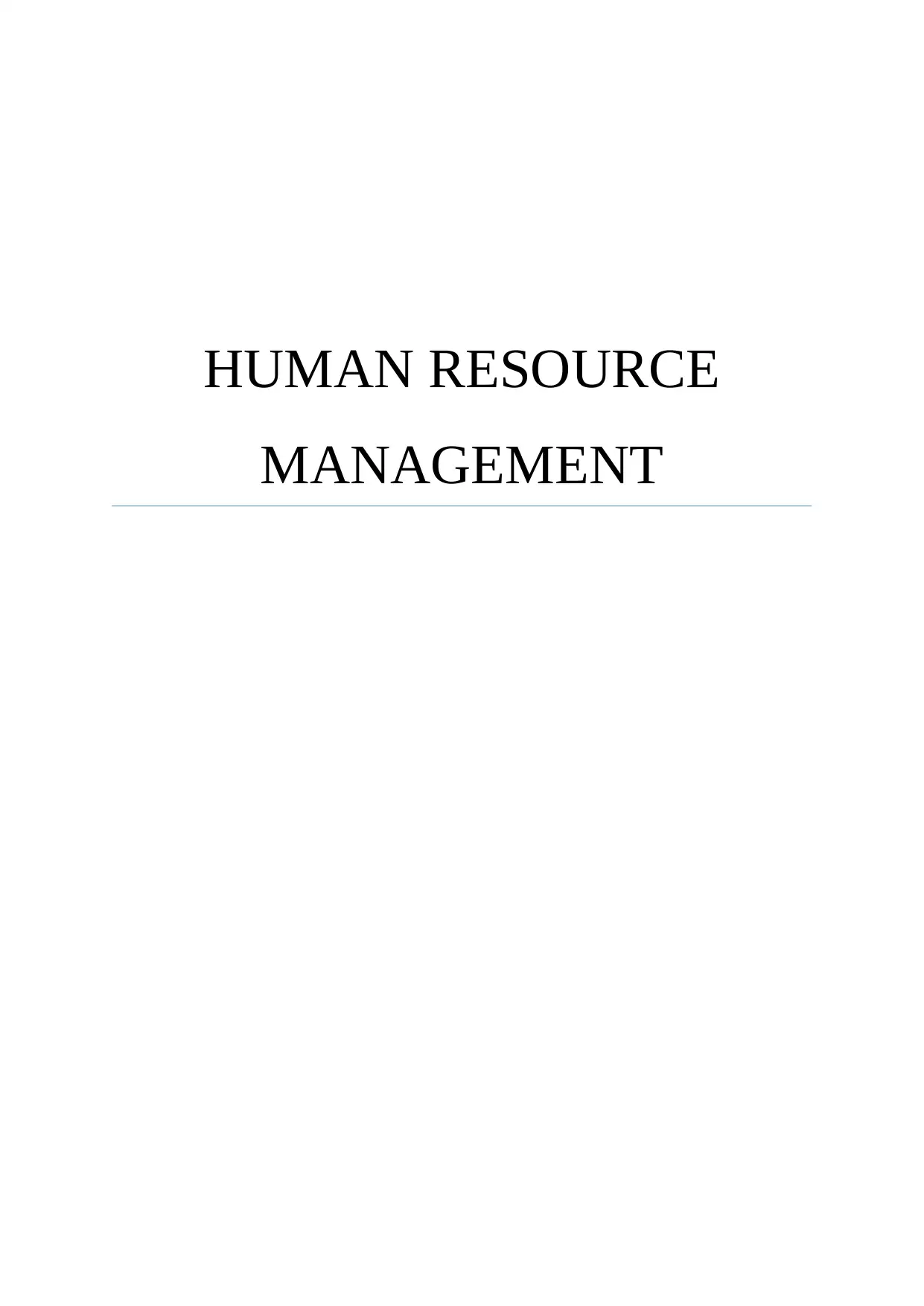
HUMAN RESOURCE
MANAGEMENT
MANAGEMENT
Paraphrase This Document
Need a fresh take? Get an instant paraphrase of this document with our AI Paraphraser
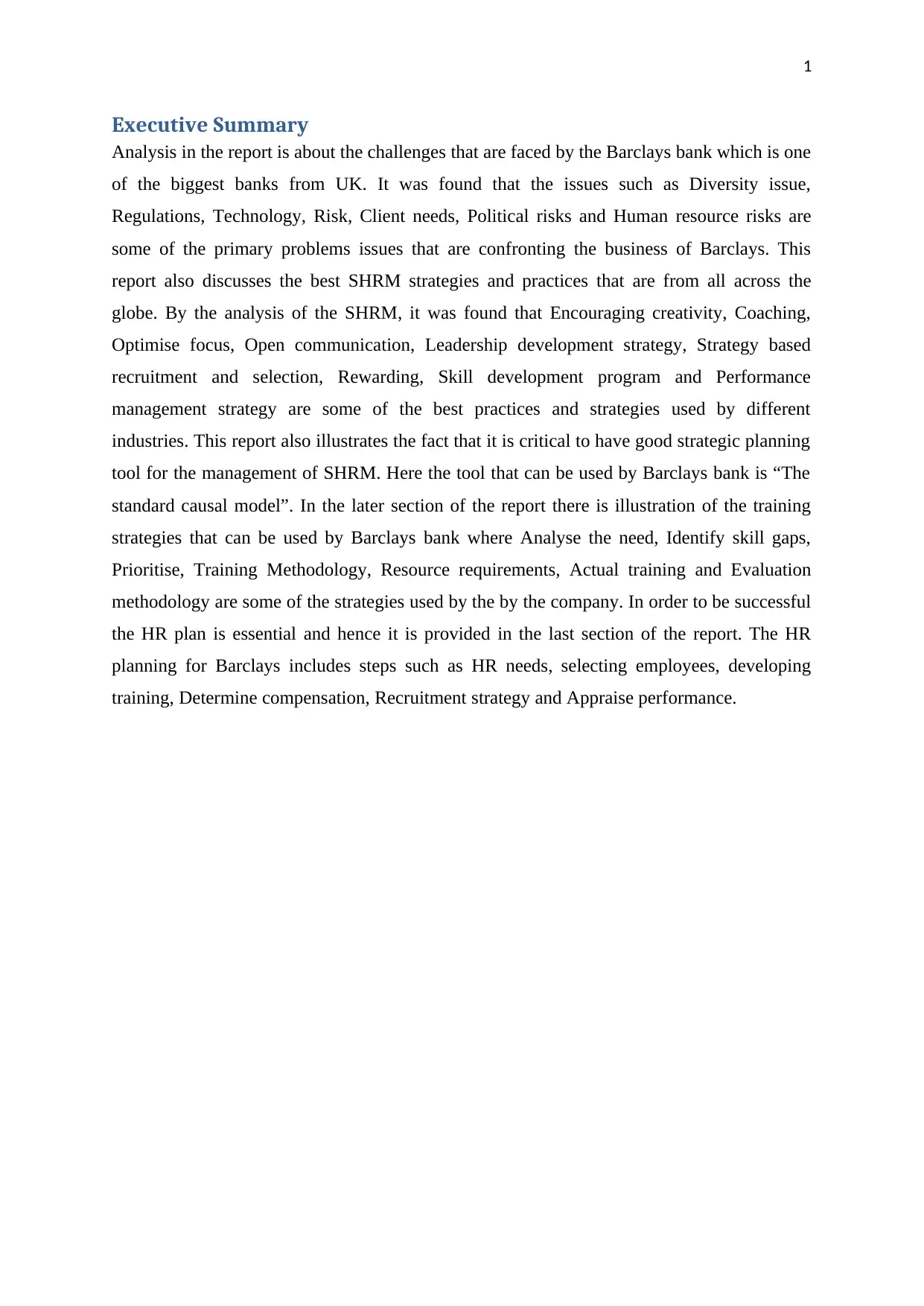
1
Executive Summary
Analysis in the report is about the challenges that are faced by the Barclays bank which is one
of the biggest banks from UK. It was found that the issues such as Diversity issue,
Regulations, Technology, Risk, Client needs, Political risks and Human resource risks are
some of the primary problems issues that are confronting the business of Barclays. This
report also discusses the best SHRM strategies and practices that are from all across the
globe. By the analysis of the SHRM, it was found that Encouraging creativity, Coaching,
Optimise focus, Open communication, Leadership development strategy, Strategy based
recruitment and selection, Rewarding, Skill development program and Performance
management strategy are some of the best practices and strategies used by different
industries. This report also illustrates the fact that it is critical to have good strategic planning
tool for the management of SHRM. Here the tool that can be used by Barclays bank is “The
standard causal model”. In the later section of the report there is illustration of the training
strategies that can be used by Barclays bank where Analyse the need, Identify skill gaps,
Prioritise, Training Methodology, Resource requirements, Actual training and Evaluation
methodology are some of the strategies used by the by the company. In order to be successful
the HR plan is essential and hence it is provided in the last section of the report. The HR
planning for Barclays includes steps such as HR needs, selecting employees, developing
training, Determine compensation, Recruitment strategy and Appraise performance.
Executive Summary
Analysis in the report is about the challenges that are faced by the Barclays bank which is one
of the biggest banks from UK. It was found that the issues such as Diversity issue,
Regulations, Technology, Risk, Client needs, Political risks and Human resource risks are
some of the primary problems issues that are confronting the business of Barclays. This
report also discusses the best SHRM strategies and practices that are from all across the
globe. By the analysis of the SHRM, it was found that Encouraging creativity, Coaching,
Optimise focus, Open communication, Leadership development strategy, Strategy based
recruitment and selection, Rewarding, Skill development program and Performance
management strategy are some of the best practices and strategies used by different
industries. This report also illustrates the fact that it is critical to have good strategic planning
tool for the management of SHRM. Here the tool that can be used by Barclays bank is “The
standard causal model”. In the later section of the report there is illustration of the training
strategies that can be used by Barclays bank where Analyse the need, Identify skill gaps,
Prioritise, Training Methodology, Resource requirements, Actual training and Evaluation
methodology are some of the strategies used by the by the company. In order to be successful
the HR plan is essential and hence it is provided in the last section of the report. The HR
planning for Barclays includes steps such as HR needs, selecting employees, developing
training, Determine compensation, Recruitment strategy and Appraise performance.
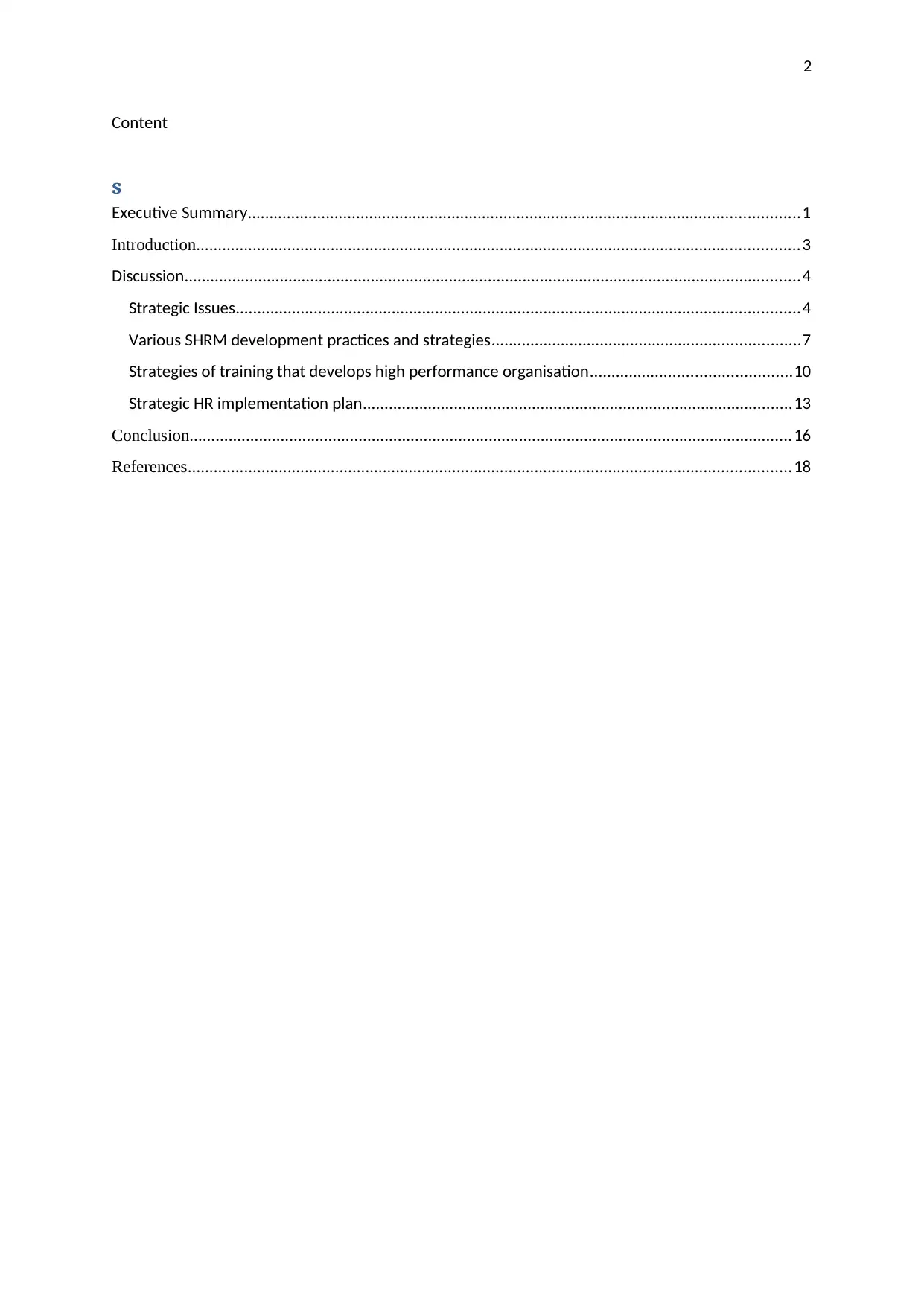
2
Content
s
Executive Summary...............................................................................................................................1
Introduction...........................................................................................................................................3
Discussion..............................................................................................................................................4
Strategic Issues..................................................................................................................................4
Various SHRM development practices and strategies.......................................................................7
Strategies of training that develops high performance organisation..............................................10
Strategic HR implementation plan...................................................................................................13
Conclusion...........................................................................................................................................16
References...........................................................................................................................................18
Content
s
Executive Summary...............................................................................................................................1
Introduction...........................................................................................................................................3
Discussion..............................................................................................................................................4
Strategic Issues..................................................................................................................................4
Various SHRM development practices and strategies.......................................................................7
Strategies of training that develops high performance organisation..............................................10
Strategic HR implementation plan...................................................................................................13
Conclusion...........................................................................................................................................16
References...........................................................................................................................................18
⊘ This is a preview!⊘
Do you want full access?
Subscribe today to unlock all pages.

Trusted by 1+ million students worldwide
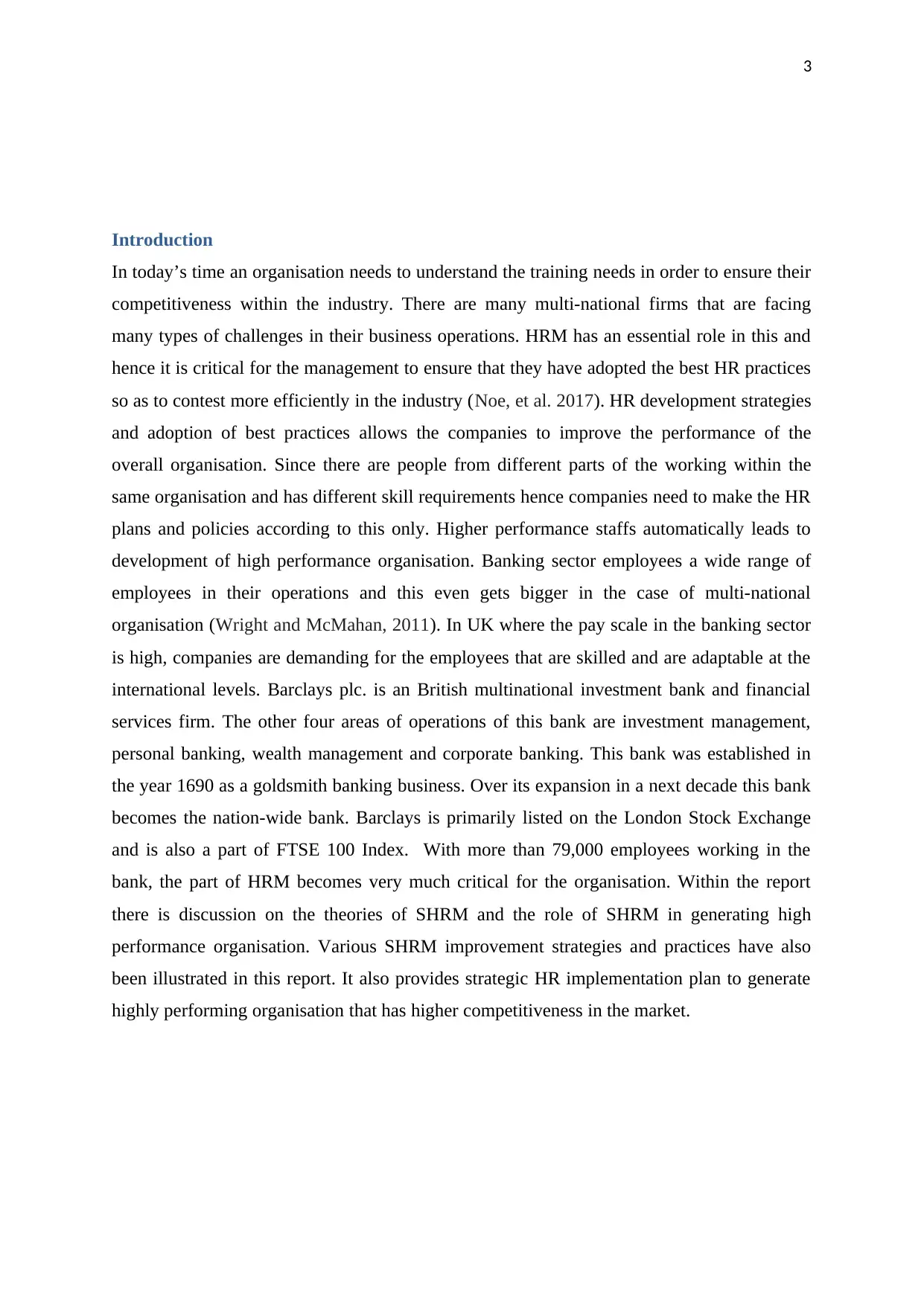
3
Introduction
In today’s time an organisation needs to understand the training needs in order to ensure their
competitiveness within the industry. There are many multi-national firms that are facing
many types of challenges in their business operations. HRM has an essential role in this and
hence it is critical for the management to ensure that they have adopted the best HR practices
so as to contest more efficiently in the industry (Noe, et al. 2017). HR development strategies
and adoption of best practices allows the companies to improve the performance of the
overall organisation. Since there are people from different parts of the working within the
same organisation and has different skill requirements hence companies need to make the HR
plans and policies according to this only. Higher performance staffs automatically leads to
development of high performance organisation. Banking sector employees a wide range of
employees in their operations and this even gets bigger in the case of multi-national
organisation (Wright and McMahan, 2011). In UK where the pay scale in the banking sector
is high, companies are demanding for the employees that are skilled and are adaptable at the
international levels. Barclays plc. is an British multinational investment bank and financial
services firm. The other four areas of operations of this bank are investment management,
personal banking, wealth management and corporate banking. This bank was established in
the year 1690 as a goldsmith banking business. Over its expansion in a next decade this bank
becomes the nation-wide bank. Barclays is primarily listed on the London Stock Exchange
and is also a part of FTSE 100 Index. With more than 79,000 employees working in the
bank, the part of HRM becomes very much critical for the organisation. Within the report
there is discussion on the theories of SHRM and the role of SHRM in generating high
performance organisation. Various SHRM improvement strategies and practices have also
been illustrated in this report. It also provides strategic HR implementation plan to generate
highly performing organisation that has higher competitiveness in the market.
Introduction
In today’s time an organisation needs to understand the training needs in order to ensure their
competitiveness within the industry. There are many multi-national firms that are facing
many types of challenges in their business operations. HRM has an essential role in this and
hence it is critical for the management to ensure that they have adopted the best HR practices
so as to contest more efficiently in the industry (Noe, et al. 2017). HR development strategies
and adoption of best practices allows the companies to improve the performance of the
overall organisation. Since there are people from different parts of the working within the
same organisation and has different skill requirements hence companies need to make the HR
plans and policies according to this only. Higher performance staffs automatically leads to
development of high performance organisation. Banking sector employees a wide range of
employees in their operations and this even gets bigger in the case of multi-national
organisation (Wright and McMahan, 2011). In UK where the pay scale in the banking sector
is high, companies are demanding for the employees that are skilled and are adaptable at the
international levels. Barclays plc. is an British multinational investment bank and financial
services firm. The other four areas of operations of this bank are investment management,
personal banking, wealth management and corporate banking. This bank was established in
the year 1690 as a goldsmith banking business. Over its expansion in a next decade this bank
becomes the nation-wide bank. Barclays is primarily listed on the London Stock Exchange
and is also a part of FTSE 100 Index. With more than 79,000 employees working in the
bank, the part of HRM becomes very much critical for the organisation. Within the report
there is discussion on the theories of SHRM and the role of SHRM in generating high
performance organisation. Various SHRM improvement strategies and practices have also
been illustrated in this report. It also provides strategic HR implementation plan to generate
highly performing organisation that has higher competitiveness in the market.
Paraphrase This Document
Need a fresh take? Get an instant paraphrase of this document with our AI Paraphraser
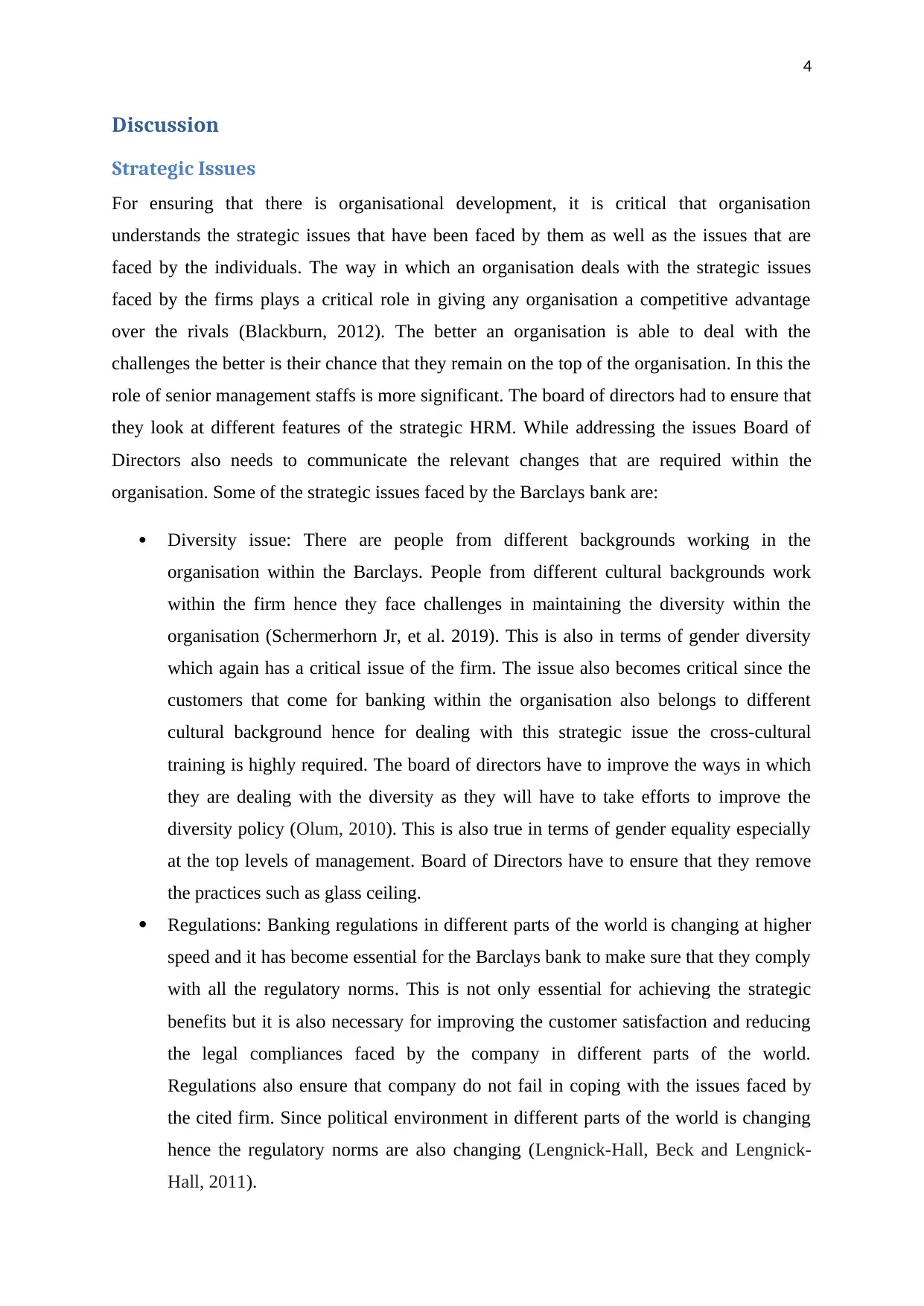
4
Discussion
Strategic Issues
For ensuring that there is organisational development, it is critical that organisation
understands the strategic issues that have been faced by them as well as the issues that are
faced by the individuals. The way in which an organisation deals with the strategic issues
faced by the firms plays a critical role in giving any organisation a competitive advantage
over the rivals (Blackburn, 2012). The better an organisation is able to deal with the
challenges the better is their chance that they remain on the top of the organisation. In this the
role of senior management staffs is more significant. The board of directors had to ensure that
they look at different features of the strategic HRM. While addressing the issues Board of
Directors also needs to communicate the relevant changes that are required within the
organisation. Some of the strategic issues faced by the Barclays bank are:
Diversity issue: There are people from different backgrounds working in the
organisation within the Barclays. People from different cultural backgrounds work
within the firm hence they face challenges in maintaining the diversity within the
organisation (Schermerhorn Jr, et al. 2019). This is also in terms of gender diversity
which again has a critical issue of the firm. The issue also becomes critical since the
customers that come for banking within the organisation also belongs to different
cultural background hence for dealing with this strategic issue the cross-cultural
training is highly required. The board of directors have to improve the ways in which
they are dealing with the diversity as they will have to take efforts to improve the
diversity policy (Olum, 2010). This is also true in terms of gender equality especially
at the top levels of management. Board of Directors have to ensure that they remove
the practices such as glass ceiling.
Regulations: Banking regulations in different parts of the world is changing at higher
speed and it has become essential for the Barclays bank to make sure that they comply
with all the regulatory norms. This is not only essential for achieving the strategic
benefits but it is also necessary for improving the customer satisfaction and reducing
the legal compliances faced by the company in different parts of the world.
Regulations also ensure that company do not fail in coping with the issues faced by
the cited firm. Since political environment in different parts of the world is changing
hence the regulatory norms are also changing (Lengnick-Hall, Beck and Lengnick-
Hall, 2011).
Discussion
Strategic Issues
For ensuring that there is organisational development, it is critical that organisation
understands the strategic issues that have been faced by them as well as the issues that are
faced by the individuals. The way in which an organisation deals with the strategic issues
faced by the firms plays a critical role in giving any organisation a competitive advantage
over the rivals (Blackburn, 2012). The better an organisation is able to deal with the
challenges the better is their chance that they remain on the top of the organisation. In this the
role of senior management staffs is more significant. The board of directors had to ensure that
they look at different features of the strategic HRM. While addressing the issues Board of
Directors also needs to communicate the relevant changes that are required within the
organisation. Some of the strategic issues faced by the Barclays bank are:
Diversity issue: There are people from different backgrounds working in the
organisation within the Barclays. People from different cultural backgrounds work
within the firm hence they face challenges in maintaining the diversity within the
organisation (Schermerhorn Jr, et al. 2019). This is also in terms of gender diversity
which again has a critical issue of the firm. The issue also becomes critical since the
customers that come for banking within the organisation also belongs to different
cultural background hence for dealing with this strategic issue the cross-cultural
training is highly required. The board of directors have to improve the ways in which
they are dealing with the diversity as they will have to take efforts to improve the
diversity policy (Olum, 2010). This is also true in terms of gender equality especially
at the top levels of management. Board of Directors have to ensure that they remove
the practices such as glass ceiling.
Regulations: Banking regulations in different parts of the world is changing at higher
speed and it has become essential for the Barclays bank to make sure that they comply
with all the regulatory norms. This is not only essential for achieving the strategic
benefits but it is also necessary for improving the customer satisfaction and reducing
the legal compliances faced by the company in different parts of the world.
Regulations also ensure that company do not fail in coping with the issues faced by
the cited firm. Since political environment in different parts of the world is changing
hence the regulatory norms are also changing (Lengnick-Hall, Beck and Lengnick-
Hall, 2011).
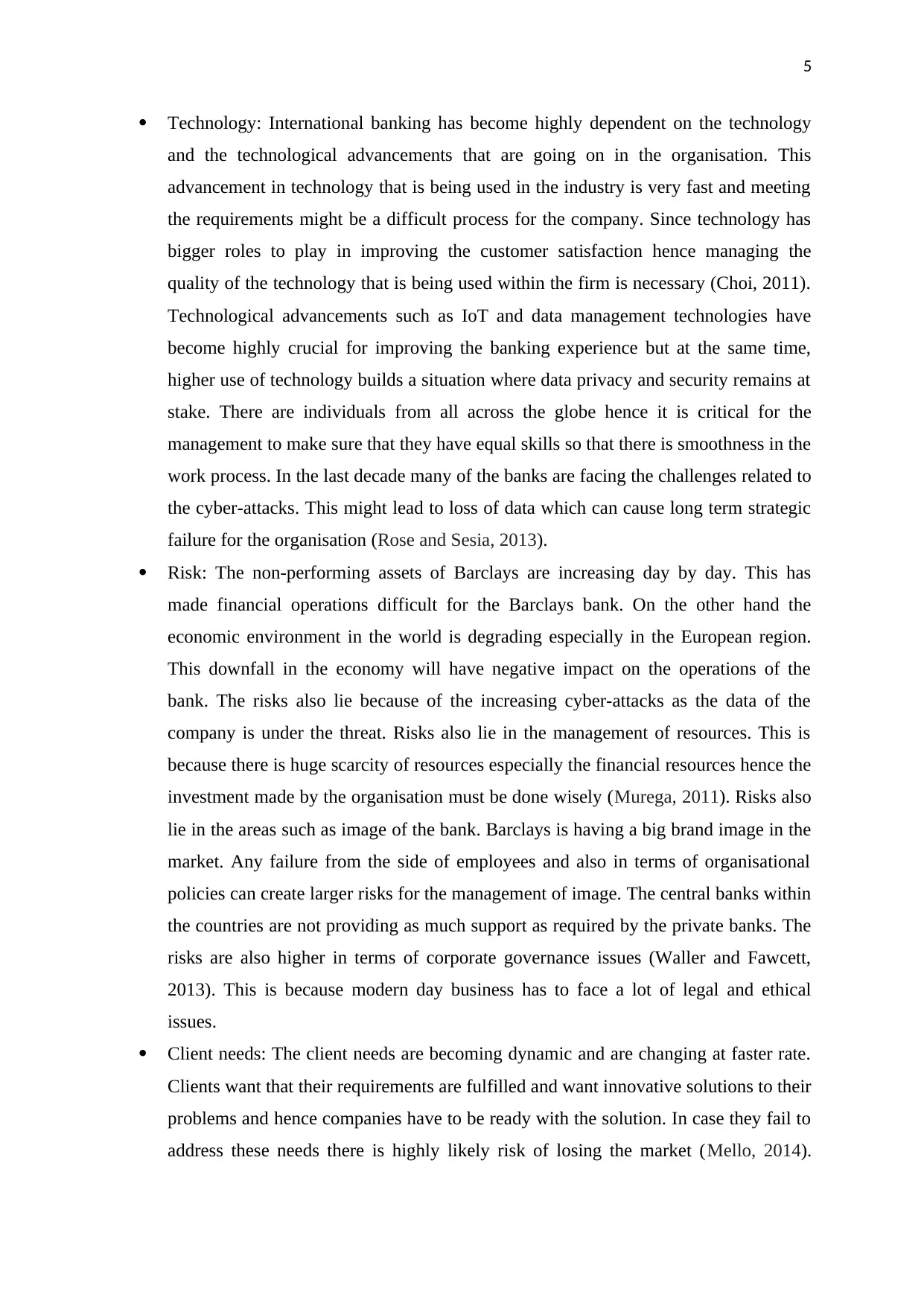
5
Technology: International banking has become highly dependent on the technology
and the technological advancements that are going on in the organisation. This
advancement in technology that is being used in the industry is very fast and meeting
the requirements might be a difficult process for the company. Since technology has
bigger roles to play in improving the customer satisfaction hence managing the
quality of the technology that is being used within the firm is necessary (Choi, 2011).
Technological advancements such as IoT and data management technologies have
become highly crucial for improving the banking experience but at the same time,
higher use of technology builds a situation where data privacy and security remains at
stake. There are individuals from all across the globe hence it is critical for the
management to make sure that they have equal skills so that there is smoothness in the
work process. In the last decade many of the banks are facing the challenges related to
the cyber-attacks. This might lead to loss of data which can cause long term strategic
failure for the organisation (Rose and Sesia, 2013).
Risk: The non-performing assets of Barclays are increasing day by day. This has
made financial operations difficult for the Barclays bank. On the other hand the
economic environment in the world is degrading especially in the European region.
This downfall in the economy will have negative impact on the operations of the
bank. The risks also lie because of the increasing cyber-attacks as the data of the
company is under the threat. Risks also lie in the management of resources. This is
because there is huge scarcity of resources especially the financial resources hence the
investment made by the organisation must be done wisely (Murega, 2011). Risks also
lie in the areas such as image of the bank. Barclays is having a big brand image in the
market. Any failure from the side of employees and also in terms of organisational
policies can create larger risks for the management of image. The central banks within
the countries are not providing as much support as required by the private banks. The
risks are also higher in terms of corporate governance issues (Waller and Fawcett,
2013). This is because modern day business has to face a lot of legal and ethical
issues.
Client needs: The client needs are becoming dynamic and are changing at faster rate.
Clients want that their requirements are fulfilled and want innovative solutions to their
problems and hence companies have to be ready with the solution. In case they fail to
address these needs there is highly likely risk of losing the market (Mello, 2014).
Technology: International banking has become highly dependent on the technology
and the technological advancements that are going on in the organisation. This
advancement in technology that is being used in the industry is very fast and meeting
the requirements might be a difficult process for the company. Since technology has
bigger roles to play in improving the customer satisfaction hence managing the
quality of the technology that is being used within the firm is necessary (Choi, 2011).
Technological advancements such as IoT and data management technologies have
become highly crucial for improving the banking experience but at the same time,
higher use of technology builds a situation where data privacy and security remains at
stake. There are individuals from all across the globe hence it is critical for the
management to make sure that they have equal skills so that there is smoothness in the
work process. In the last decade many of the banks are facing the challenges related to
the cyber-attacks. This might lead to loss of data which can cause long term strategic
failure for the organisation (Rose and Sesia, 2013).
Risk: The non-performing assets of Barclays are increasing day by day. This has
made financial operations difficult for the Barclays bank. On the other hand the
economic environment in the world is degrading especially in the European region.
This downfall in the economy will have negative impact on the operations of the
bank. The risks also lie because of the increasing cyber-attacks as the data of the
company is under the threat. Risks also lie in the management of resources. This is
because there is huge scarcity of resources especially the financial resources hence the
investment made by the organisation must be done wisely (Murega, 2011). Risks also
lie in the areas such as image of the bank. Barclays is having a big brand image in the
market. Any failure from the side of employees and also in terms of organisational
policies can create larger risks for the management of image. The central banks within
the countries are not providing as much support as required by the private banks. The
risks are also higher in terms of corporate governance issues (Waller and Fawcett,
2013). This is because modern day business has to face a lot of legal and ethical
issues.
Client needs: The client needs are becoming dynamic and are changing at faster rate.
Clients want that their requirements are fulfilled and want innovative solutions to their
problems and hence companies have to be ready with the solution. In case they fail to
address these needs there is highly likely risk of losing the market (Mello, 2014).
⊘ This is a preview!⊘
Do you want full access?
Subscribe today to unlock all pages.

Trusted by 1+ million students worldwide
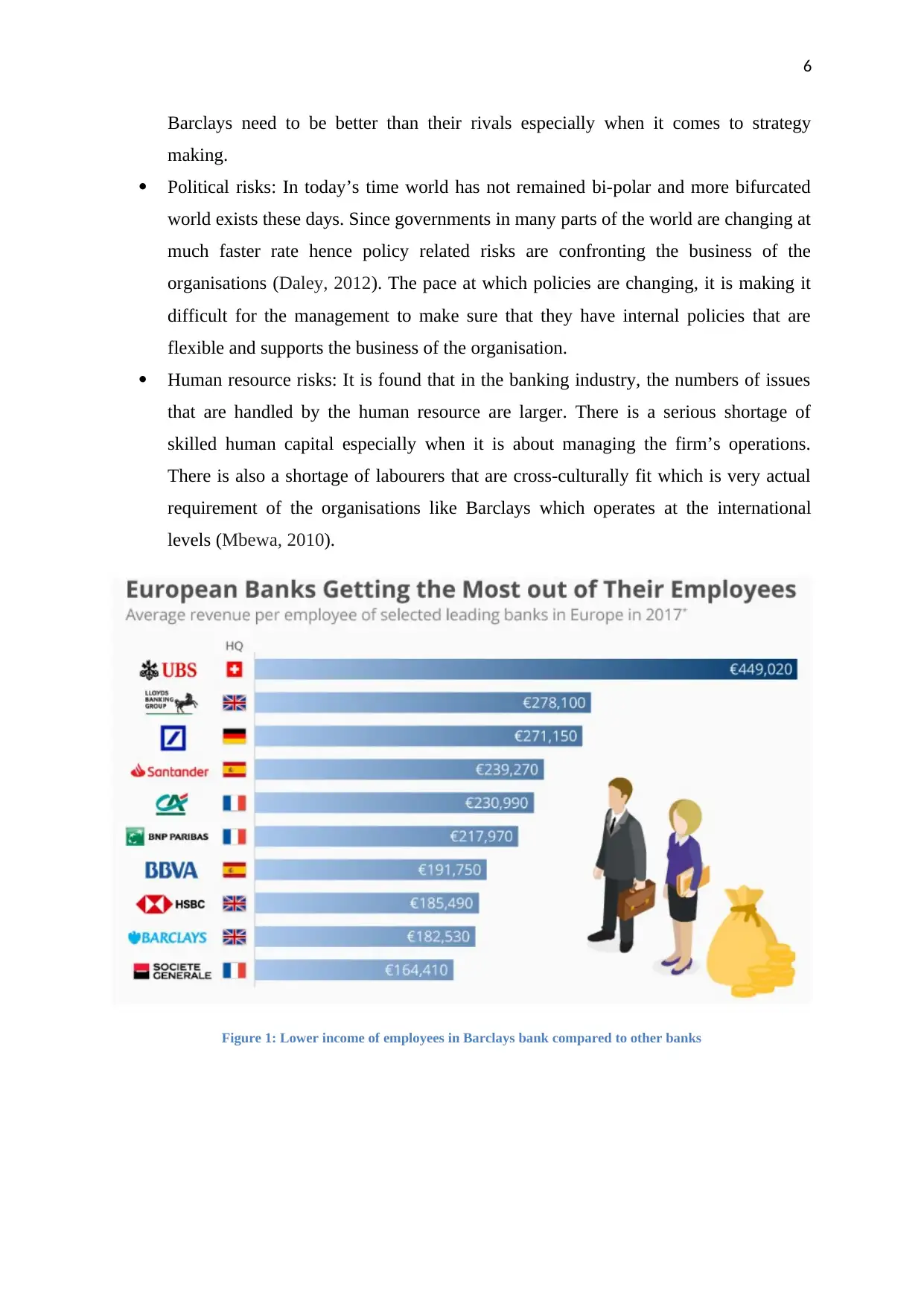
6
Barclays need to be better than their rivals especially when it comes to strategy
making.
Political risks: In today’s time world has not remained bi-polar and more bifurcated
world exists these days. Since governments in many parts of the world are changing at
much faster rate hence policy related risks are confronting the business of the
organisations (Daley, 2012). The pace at which policies are changing, it is making it
difficult for the management to make sure that they have internal policies that are
flexible and supports the business of the organisation.
Human resource risks: It is found that in the banking industry, the numbers of issues
that are handled by the human resource are larger. There is a serious shortage of
skilled human capital especially when it is about managing the firm’s operations.
There is also a shortage of labourers that are cross-culturally fit which is very actual
requirement of the organisations like Barclays which operates at the international
levels (Mbewa, 2010).
Figure 1: Lower income of employees in Barclays bank compared to other banks
Barclays need to be better than their rivals especially when it comes to strategy
making.
Political risks: In today’s time world has not remained bi-polar and more bifurcated
world exists these days. Since governments in many parts of the world are changing at
much faster rate hence policy related risks are confronting the business of the
organisations (Daley, 2012). The pace at which policies are changing, it is making it
difficult for the management to make sure that they have internal policies that are
flexible and supports the business of the organisation.
Human resource risks: It is found that in the banking industry, the numbers of issues
that are handled by the human resource are larger. There is a serious shortage of
skilled human capital especially when it is about managing the firm’s operations.
There is also a shortage of labourers that are cross-culturally fit which is very actual
requirement of the organisations like Barclays which operates at the international
levels (Mbewa, 2010).
Figure 1: Lower income of employees in Barclays bank compared to other banks
Paraphrase This Document
Need a fresh take? Get an instant paraphrase of this document with our AI Paraphraser
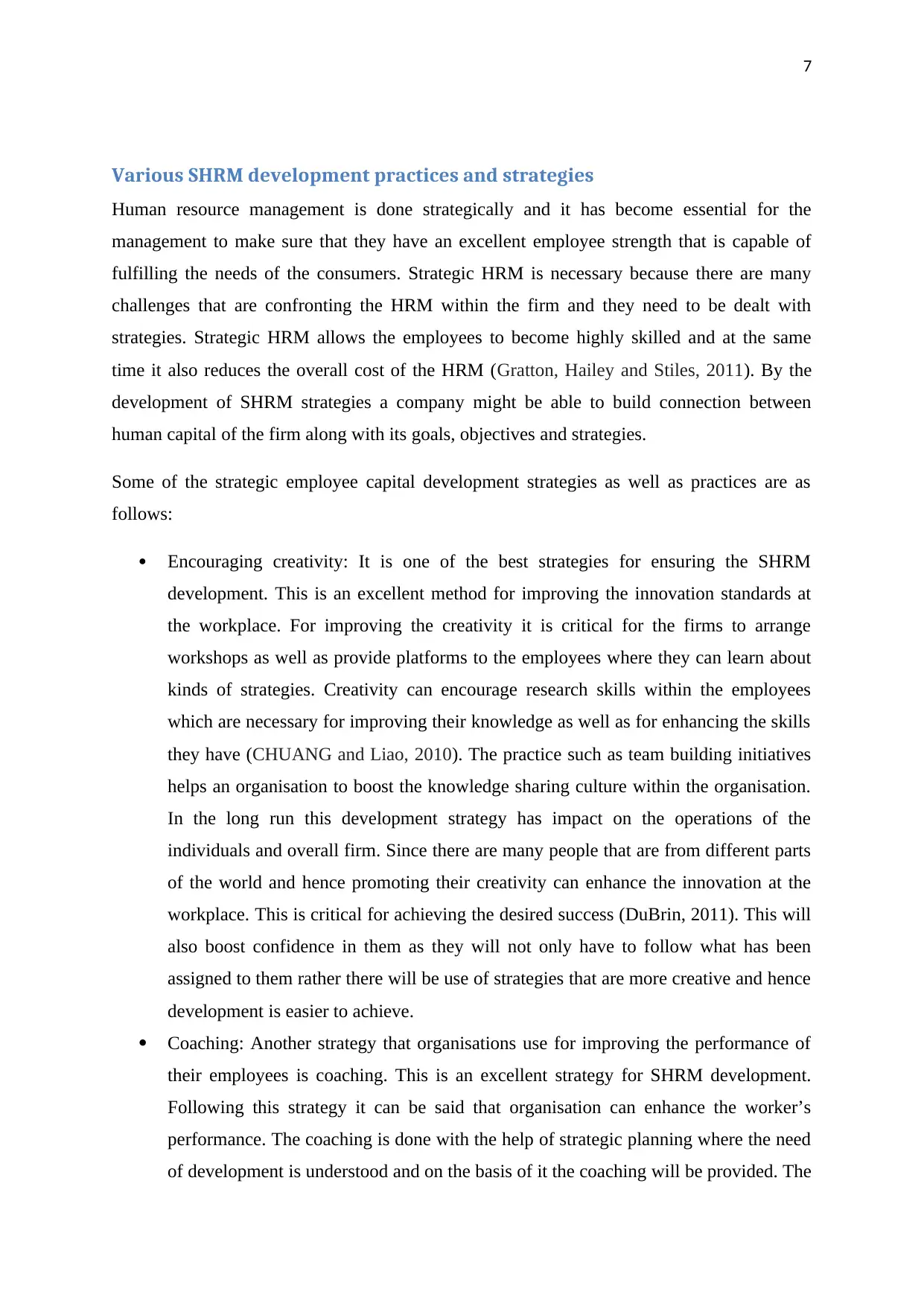
7
Various SHRM development practices and strategies
Human resource management is done strategically and it has become essential for the
management to make sure that they have an excellent employee strength that is capable of
fulfilling the needs of the consumers. Strategic HRM is necessary because there are many
challenges that are confronting the HRM within the firm and they need to be dealt with
strategies. Strategic HRM allows the employees to become highly skilled and at the same
time it also reduces the overall cost of the HRM (Gratton, Hailey and Stiles, 2011). By the
development of SHRM strategies a company might be able to build connection between
human capital of the firm along with its goals, objectives and strategies.
Some of the strategic employee capital development strategies as well as practices are as
follows:
Encouraging creativity: It is one of the best strategies for ensuring the SHRM
development. This is an excellent method for improving the innovation standards at
the workplace. For improving the creativity it is critical for the firms to arrange
workshops as well as provide platforms to the employees where they can learn about
kinds of strategies. Creativity can encourage research skills within the employees
which are necessary for improving their knowledge as well as for enhancing the skills
they have (CHUANG and Liao, 2010). The practice such as team building initiatives
helps an organisation to boost the knowledge sharing culture within the organisation.
In the long run this development strategy has impact on the operations of the
individuals and overall firm. Since there are many people that are from different parts
of the world and hence promoting their creativity can enhance the innovation at the
workplace. This is critical for achieving the desired success (DuBrin, 2011). This will
also boost confidence in them as they will not only have to follow what has been
assigned to them rather there will be use of strategies that are more creative and hence
development is easier to achieve.
Coaching: Another strategy that organisations use for improving the performance of
their employees is coaching. This is an excellent strategy for SHRM development.
Following this strategy it can be said that organisation can enhance the worker’s
performance. The coaching is done with the help of strategic planning where the need
of development is understood and on the basis of it the coaching will be provided. The
Various SHRM development practices and strategies
Human resource management is done strategically and it has become essential for the
management to make sure that they have an excellent employee strength that is capable of
fulfilling the needs of the consumers. Strategic HRM is necessary because there are many
challenges that are confronting the HRM within the firm and they need to be dealt with
strategies. Strategic HRM allows the employees to become highly skilled and at the same
time it also reduces the overall cost of the HRM (Gratton, Hailey and Stiles, 2011). By the
development of SHRM strategies a company might be able to build connection between
human capital of the firm along with its goals, objectives and strategies.
Some of the strategic employee capital development strategies as well as practices are as
follows:
Encouraging creativity: It is one of the best strategies for ensuring the SHRM
development. This is an excellent method for improving the innovation standards at
the workplace. For improving the creativity it is critical for the firms to arrange
workshops as well as provide platforms to the employees where they can learn about
kinds of strategies. Creativity can encourage research skills within the employees
which are necessary for improving their knowledge as well as for enhancing the skills
they have (CHUANG and Liao, 2010). The practice such as team building initiatives
helps an organisation to boost the knowledge sharing culture within the organisation.
In the long run this development strategy has impact on the operations of the
individuals and overall firm. Since there are many people that are from different parts
of the world and hence promoting their creativity can enhance the innovation at the
workplace. This is critical for achieving the desired success (DuBrin, 2011). This will
also boost confidence in them as they will not only have to follow what has been
assigned to them rather there will be use of strategies that are more creative and hence
development is easier to achieve.
Coaching: Another strategy that organisations use for improving the performance of
their employees is coaching. This is an excellent strategy for SHRM development.
Following this strategy it can be said that organisation can enhance the worker’s
performance. The coaching is done with the help of strategic planning where the need
of development is understood and on the basis of it the coaching will be provided. The
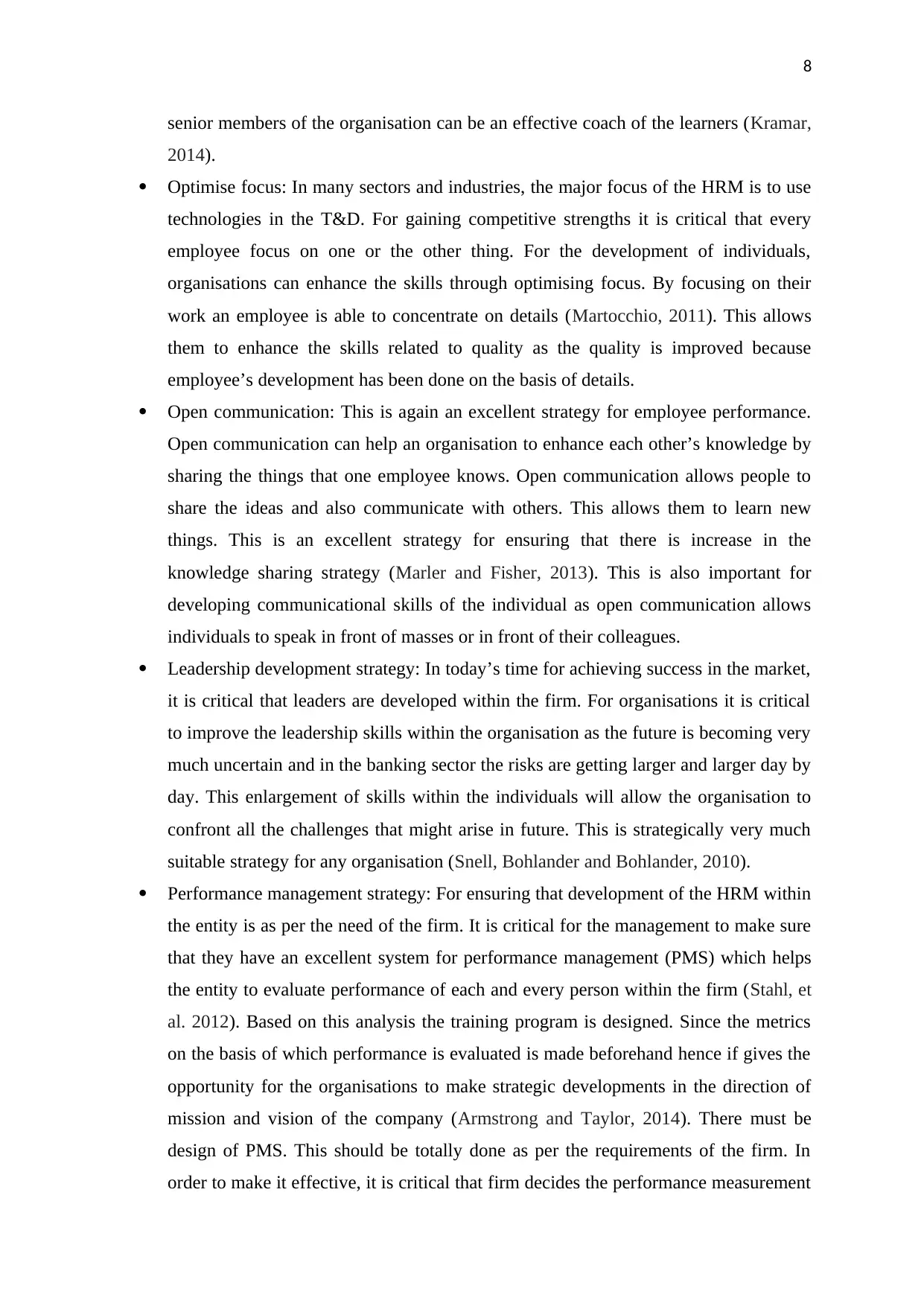
8
senior members of the organisation can be an effective coach of the learners (Kramar,
2014).
Optimise focus: In many sectors and industries, the major focus of the HRM is to use
technologies in the T&D. For gaining competitive strengths it is critical that every
employee focus on one or the other thing. For the development of individuals,
organisations can enhance the skills through optimising focus. By focusing on their
work an employee is able to concentrate on details (Martocchio, 2011). This allows
them to enhance the skills related to quality as the quality is improved because
employee’s development has been done on the basis of details.
Open communication: This is again an excellent strategy for employee performance.
Open communication can help an organisation to enhance each other’s knowledge by
sharing the things that one employee knows. Open communication allows people to
share the ideas and also communicate with others. This allows them to learn new
things. This is an excellent strategy for ensuring that there is increase in the
knowledge sharing strategy (Marler and Fisher, 2013). This is also important for
developing communicational skills of the individual as open communication allows
individuals to speak in front of masses or in front of their colleagues.
Leadership development strategy: In today’s time for achieving success in the market,
it is critical that leaders are developed within the firm. For organisations it is critical
to improve the leadership skills within the organisation as the future is becoming very
much uncertain and in the banking sector the risks are getting larger and larger day by
day. This enlargement of skills within the individuals will allow the organisation to
confront all the challenges that might arise in future. This is strategically very much
suitable strategy for any organisation (Snell, Bohlander and Bohlander, 2010).
Performance management strategy: For ensuring that development of the HRM within
the entity is as per the need of the firm. It is critical for the management to make sure
that they have an excellent system for performance management (PMS) which helps
the entity to evaluate performance of each and every person within the firm (Stahl, et
al. 2012). Based on this analysis the training program is designed. Since the metrics
on the basis of which performance is evaluated is made beforehand hence if gives the
opportunity for the organisations to make strategic developments in the direction of
mission and vision of the company (Armstrong and Taylor, 2014). There must be
design of PMS. This should be totally done as per the requirements of the firm. In
order to make it effective, it is critical that firm decides the performance measurement
senior members of the organisation can be an effective coach of the learners (Kramar,
2014).
Optimise focus: In many sectors and industries, the major focus of the HRM is to use
technologies in the T&D. For gaining competitive strengths it is critical that every
employee focus on one or the other thing. For the development of individuals,
organisations can enhance the skills through optimising focus. By focusing on their
work an employee is able to concentrate on details (Martocchio, 2011). This allows
them to enhance the skills related to quality as the quality is improved because
employee’s development has been done on the basis of details.
Open communication: This is again an excellent strategy for employee performance.
Open communication can help an organisation to enhance each other’s knowledge by
sharing the things that one employee knows. Open communication allows people to
share the ideas and also communicate with others. This allows them to learn new
things. This is an excellent strategy for ensuring that there is increase in the
knowledge sharing strategy (Marler and Fisher, 2013). This is also important for
developing communicational skills of the individual as open communication allows
individuals to speak in front of masses or in front of their colleagues.
Leadership development strategy: In today’s time for achieving success in the market,
it is critical that leaders are developed within the firm. For organisations it is critical
to improve the leadership skills within the organisation as the future is becoming very
much uncertain and in the banking sector the risks are getting larger and larger day by
day. This enlargement of skills within the individuals will allow the organisation to
confront all the challenges that might arise in future. This is strategically very much
suitable strategy for any organisation (Snell, Bohlander and Bohlander, 2010).
Performance management strategy: For ensuring that development of the HRM within
the entity is as per the need of the firm. It is critical for the management to make sure
that they have an excellent system for performance management (PMS) which helps
the entity to evaluate performance of each and every person within the firm (Stahl, et
al. 2012). Based on this analysis the training program is designed. Since the metrics
on the basis of which performance is evaluated is made beforehand hence if gives the
opportunity for the organisations to make strategic developments in the direction of
mission and vision of the company (Armstrong and Taylor, 2014). There must be
design of PMS. This should be totally done as per the requirements of the firm. In
order to make it effective, it is critical that firm decides the performance measurement
⊘ This is a preview!⊘
Do you want full access?
Subscribe today to unlock all pages.

Trusted by 1+ million students worldwide
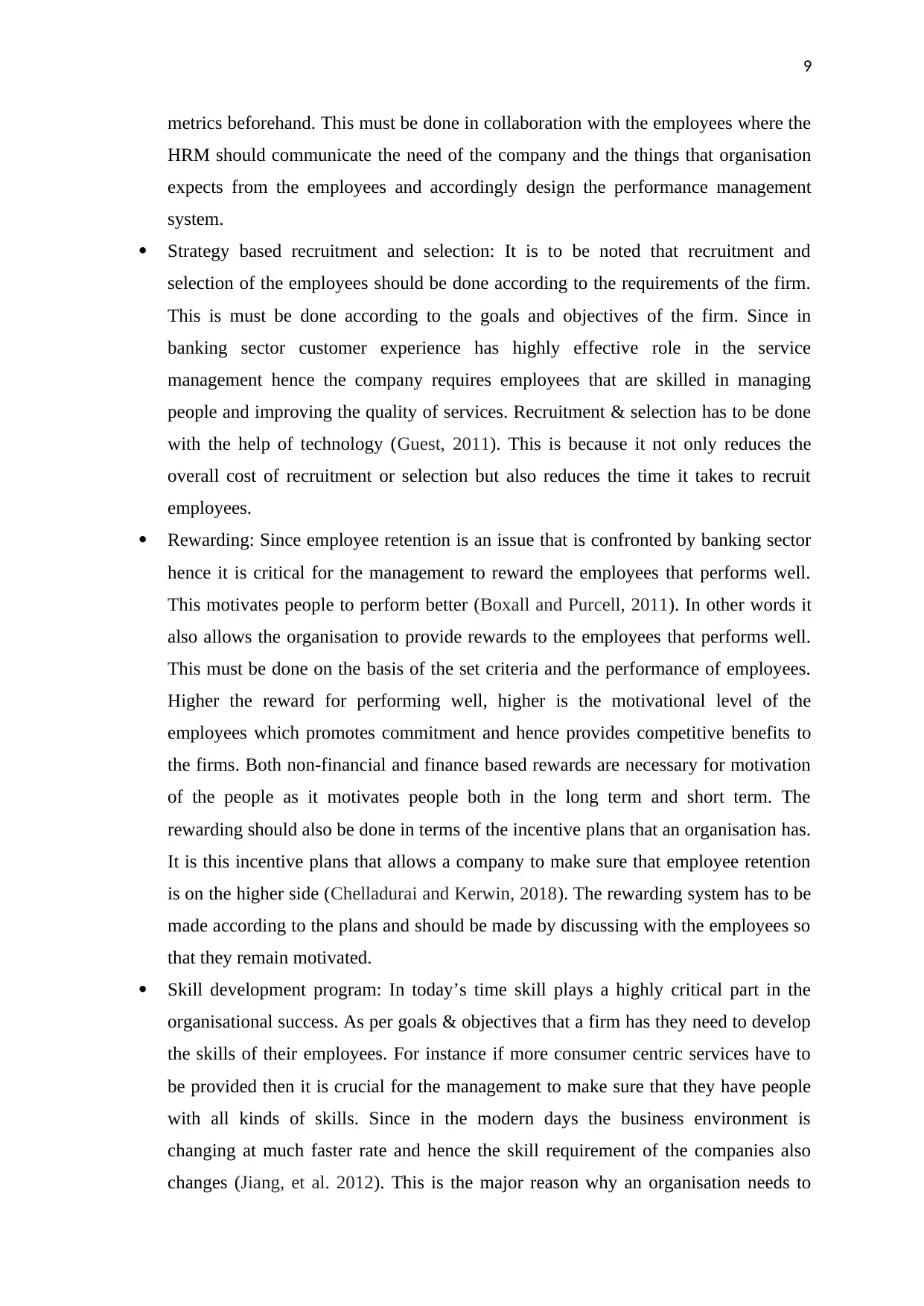
9
metrics beforehand. This must be done in collaboration with the employees where the
HRM should communicate the need of the company and the things that organisation
expects from the employees and accordingly design the performance management
system.
Strategy based recruitment and selection: It is to be noted that recruitment and
selection of the employees should be done according to the requirements of the firm.
This is must be done according to the goals and objectives of the firm. Since in
banking sector customer experience has highly effective role in the service
management hence the company requires employees that are skilled in managing
people and improving the quality of services. Recruitment & selection has to be done
with the help of technology (Guest, 2011). This is because it not only reduces the
overall cost of recruitment or selection but also reduces the time it takes to recruit
employees.
Rewarding: Since employee retention is an issue that is confronted by banking sector
hence it is critical for the management to reward the employees that performs well.
This motivates people to perform better (Boxall and Purcell, 2011). In other words it
also allows the organisation to provide rewards to the employees that performs well.
This must be done on the basis of the set criteria and the performance of employees.
Higher the reward for performing well, higher is the motivational level of the
employees which promotes commitment and hence provides competitive benefits to
the firms. Both non-financial and finance based rewards are necessary for motivation
of the people as it motivates people both in the long term and short term. The
rewarding should also be done in terms of the incentive plans that an organisation has.
It is this incentive plans that allows a company to make sure that employee retention
is on the higher side (Chelladurai and Kerwin, 2018). The rewarding system has to be
made according to the plans and should be made by discussing with the employees so
that they remain motivated.
Skill development program: In today’s time skill plays a highly critical part in the
organisational success. As per goals & objectives that a firm has they need to develop
the skills of their employees. For instance if more consumer centric services have to
be provided then it is crucial for the management to make sure that they have people
with all kinds of skills. Since in the modern days the business environment is
changing at much faster rate and hence the skill requirement of the companies also
changes (Jiang, et al. 2012). This is the major reason why an organisation needs to
metrics beforehand. This must be done in collaboration with the employees where the
HRM should communicate the need of the company and the things that organisation
expects from the employees and accordingly design the performance management
system.
Strategy based recruitment and selection: It is to be noted that recruitment and
selection of the employees should be done according to the requirements of the firm.
This is must be done according to the goals and objectives of the firm. Since in
banking sector customer experience has highly effective role in the service
management hence the company requires employees that are skilled in managing
people and improving the quality of services. Recruitment & selection has to be done
with the help of technology (Guest, 2011). This is because it not only reduces the
overall cost of recruitment or selection but also reduces the time it takes to recruit
employees.
Rewarding: Since employee retention is an issue that is confronted by banking sector
hence it is critical for the management to reward the employees that performs well.
This motivates people to perform better (Boxall and Purcell, 2011). In other words it
also allows the organisation to provide rewards to the employees that performs well.
This must be done on the basis of the set criteria and the performance of employees.
Higher the reward for performing well, higher is the motivational level of the
employees which promotes commitment and hence provides competitive benefits to
the firms. Both non-financial and finance based rewards are necessary for motivation
of the people as it motivates people both in the long term and short term. The
rewarding should also be done in terms of the incentive plans that an organisation has.
It is this incentive plans that allows a company to make sure that employee retention
is on the higher side (Chelladurai and Kerwin, 2018). The rewarding system has to be
made according to the plans and should be made by discussing with the employees so
that they remain motivated.
Skill development program: In today’s time skill plays a highly critical part in the
organisational success. As per goals & objectives that a firm has they need to develop
the skills of their employees. For instance if more consumer centric services have to
be provided then it is crucial for the management to make sure that they have people
with all kinds of skills. Since in the modern days the business environment is
changing at much faster rate and hence the skill requirement of the companies also
changes (Jiang, et al. 2012). This is the major reason why an organisation needs to
Paraphrase This Document
Need a fresh take? Get an instant paraphrase of this document with our AI Paraphraser
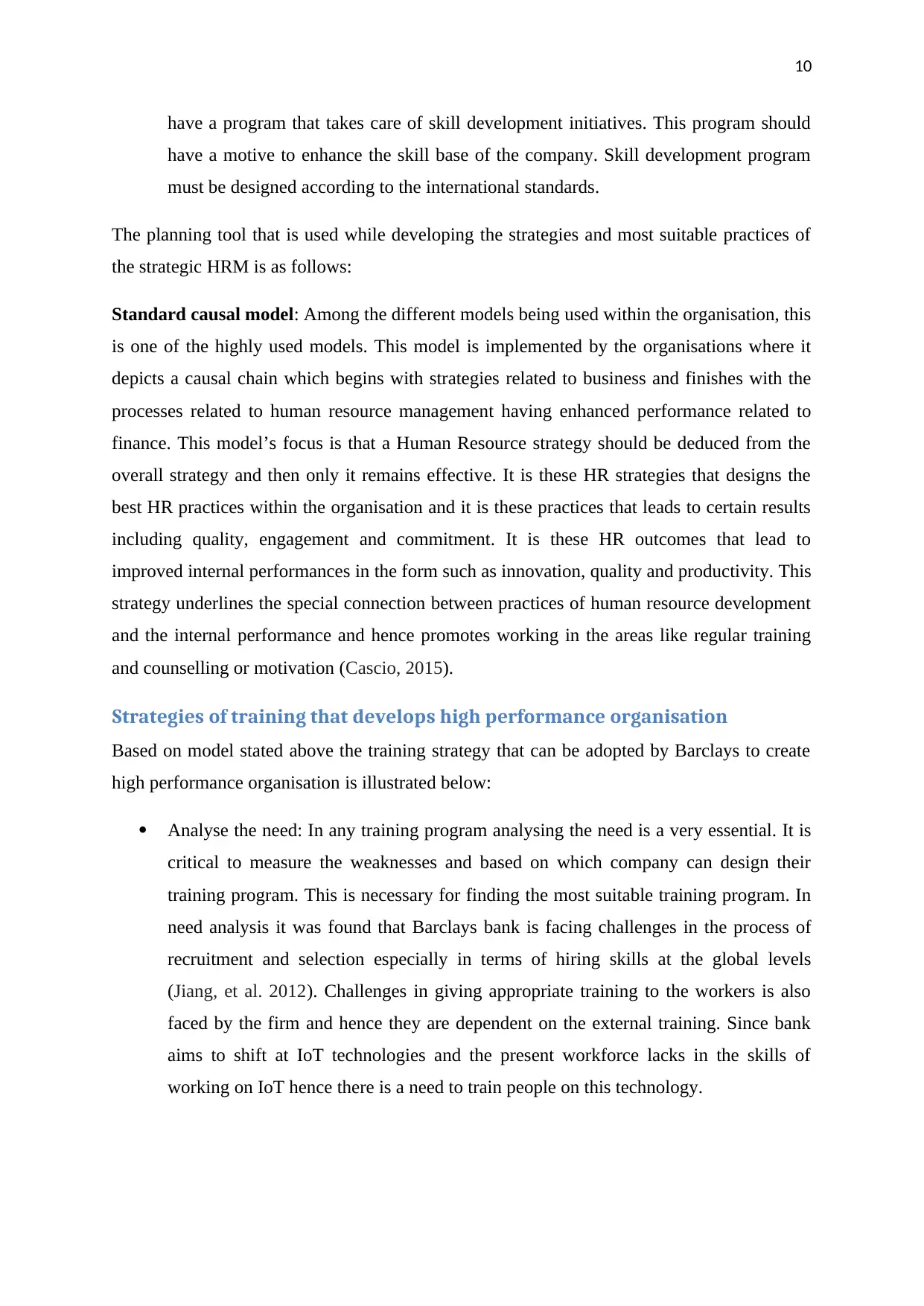
10
have a program that takes care of skill development initiatives. This program should
have a motive to enhance the skill base of the company. Skill development program
must be designed according to the international standards.
The planning tool that is used while developing the strategies and most suitable practices of
the strategic HRM is as follows:
Standard causal model: Among the different models being used within the organisation, this
is one of the highly used models. This model is implemented by the organisations where it
depicts a causal chain which begins with strategies related to business and finishes with the
processes related to human resource management having enhanced performance related to
finance. This model’s focus is that a Human Resource strategy should be deduced from the
overall strategy and then only it remains effective. It is these HR strategies that designs the
best HR practices within the organisation and it is these practices that leads to certain results
including quality, engagement and commitment. It is these HR outcomes that lead to
improved internal performances in the form such as innovation, quality and productivity. This
strategy underlines the special connection between practices of human resource development
and the internal performance and hence promotes working in the areas like regular training
and counselling or motivation (Cascio, 2015).
Strategies of training that develops high performance organisation
Based on model stated above the training strategy that can be adopted by Barclays to create
high performance organisation is illustrated below:
Analyse the need: In any training program analysing the need is a very essential. It is
critical to measure the weaknesses and based on which company can design their
training program. This is necessary for finding the most suitable training program. In
need analysis it was found that Barclays bank is facing challenges in the process of
recruitment and selection especially in terms of hiring skills at the global levels
(Jiang, et al. 2012). Challenges in giving appropriate training to the workers is also
faced by the firm and hence they are dependent on the external training. Since bank
aims to shift at IoT technologies and the present workforce lacks in the skills of
working on IoT hence there is a need to train people on this technology.
have a program that takes care of skill development initiatives. This program should
have a motive to enhance the skill base of the company. Skill development program
must be designed according to the international standards.
The planning tool that is used while developing the strategies and most suitable practices of
the strategic HRM is as follows:
Standard causal model: Among the different models being used within the organisation, this
is one of the highly used models. This model is implemented by the organisations where it
depicts a causal chain which begins with strategies related to business and finishes with the
processes related to human resource management having enhanced performance related to
finance. This model’s focus is that a Human Resource strategy should be deduced from the
overall strategy and then only it remains effective. It is these HR strategies that designs the
best HR practices within the organisation and it is these practices that leads to certain results
including quality, engagement and commitment. It is these HR outcomes that lead to
improved internal performances in the form such as innovation, quality and productivity. This
strategy underlines the special connection between practices of human resource development
and the internal performance and hence promotes working in the areas like regular training
and counselling or motivation (Cascio, 2015).
Strategies of training that develops high performance organisation
Based on model stated above the training strategy that can be adopted by Barclays to create
high performance organisation is illustrated below:
Analyse the need: In any training program analysing the need is a very essential. It is
critical to measure the weaknesses and based on which company can design their
training program. This is necessary for finding the most suitable training program. In
need analysis it was found that Barclays bank is facing challenges in the process of
recruitment and selection especially in terms of hiring skills at the global levels
(Jiang, et al. 2012). Challenges in giving appropriate training to the workers is also
faced by the firm and hence they are dependent on the external training. Since bank
aims to shift at IoT technologies and the present workforce lacks in the skills of
working on IoT hence there is a need to train people on this technology.
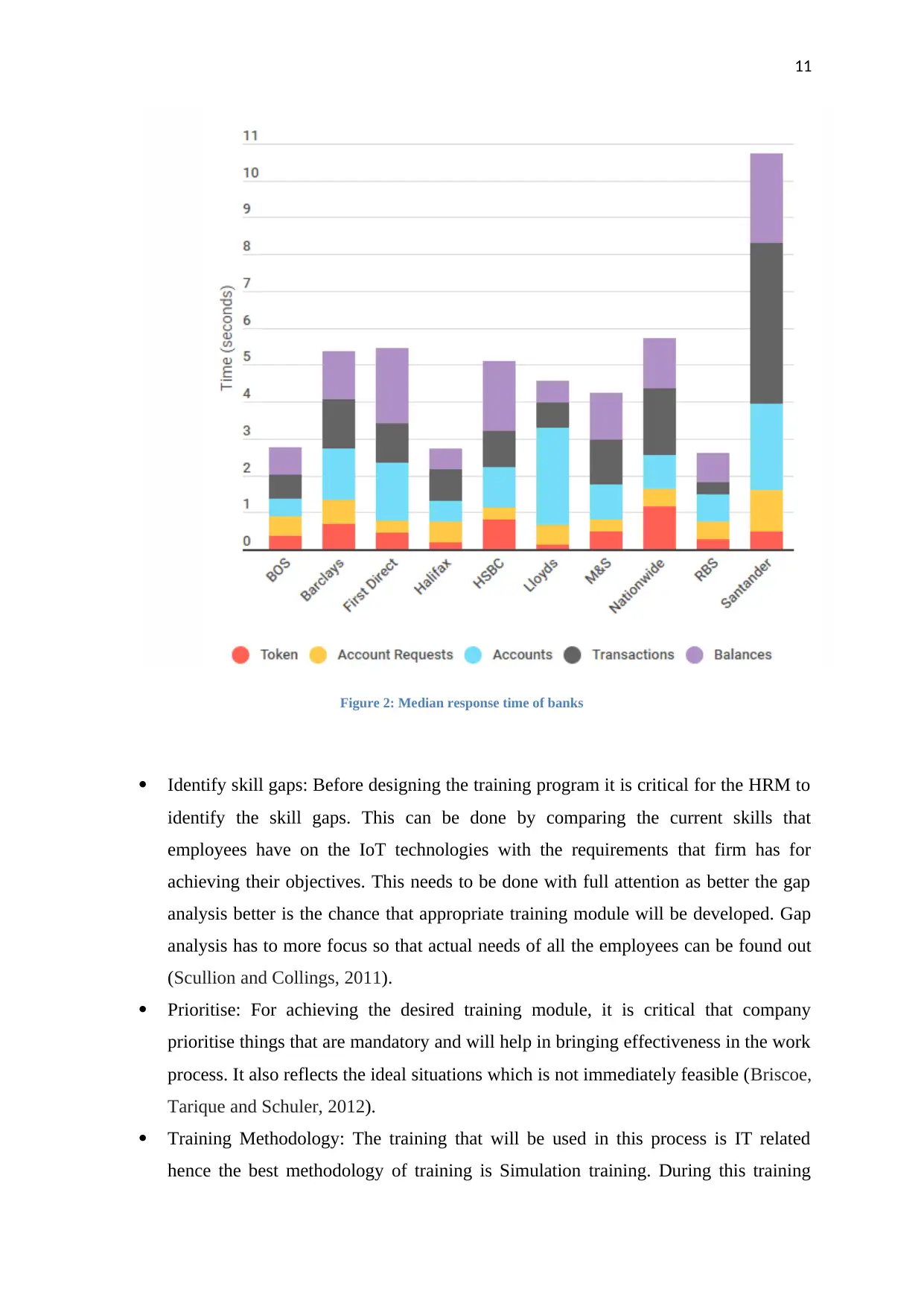
11
Figure 2: Median response time of banks
Identify skill gaps: Before designing the training program it is critical for the HRM to
identify the skill gaps. This can be done by comparing the current skills that
employees have on the IoT technologies with the requirements that firm has for
achieving their objectives. This needs to be done with full attention as better the gap
analysis better is the chance that appropriate training module will be developed. Gap
analysis has to more focus so that actual needs of all the employees can be found out
(Scullion and Collings, 2011).
Prioritise: For achieving the desired training module, it is critical that company
prioritise things that are mandatory and will help in bringing effectiveness in the work
process. It also reflects the ideal situations which is not immediately feasible (Briscoe,
Tarique and Schuler, 2012).
Training Methodology: The training that will be used in this process is IT related
hence the best methodology of training is Simulation training. During this training
Figure 2: Median response time of banks
Identify skill gaps: Before designing the training program it is critical for the HRM to
identify the skill gaps. This can be done by comparing the current skills that
employees have on the IoT technologies with the requirements that firm has for
achieving their objectives. This needs to be done with full attention as better the gap
analysis better is the chance that appropriate training module will be developed. Gap
analysis has to more focus so that actual needs of all the employees can be found out
(Scullion and Collings, 2011).
Prioritise: For achieving the desired training module, it is critical that company
prioritise things that are mandatory and will help in bringing effectiveness in the work
process. It also reflects the ideal situations which is not immediately feasible (Briscoe,
Tarique and Schuler, 2012).
Training Methodology: The training that will be used in this process is IT related
hence the best methodology of training is Simulation training. During this training
⊘ This is a preview!⊘
Do you want full access?
Subscribe today to unlock all pages.

Trusted by 1+ million students worldwide
1 out of 23
Related Documents
Your All-in-One AI-Powered Toolkit for Academic Success.
+13062052269
info@desklib.com
Available 24*7 on WhatsApp / Email
![[object Object]](/_next/static/media/star-bottom.7253800d.svg)
Unlock your academic potential
Copyright © 2020–2025 A2Z Services. All Rights Reserved. Developed and managed by ZUCOL.





